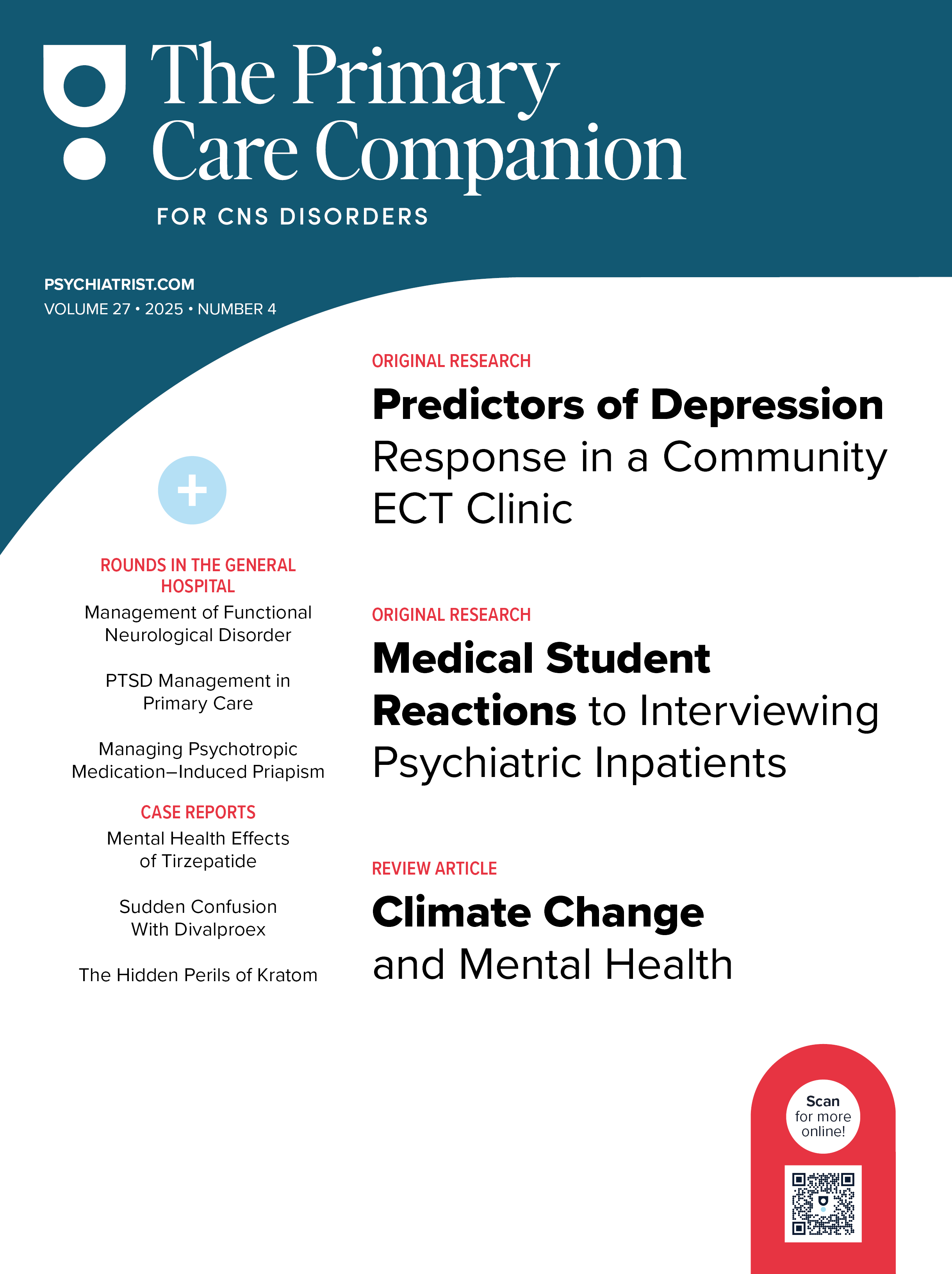
Successful Long-Acting Paliperidone Treatment Following Reversible Risperidone-Induced Neutropenia
Neuroleptic-induced neutropenia and other blood dyscrasias are an established potential side effect of all second-generation antipsychotic medications. Neutropenia is typically defined by an absolute neutrophil count (ANC) < 1,500/uL, which puts patients at high risk for opportunistic infections.1 As of now, there is no standard practice for management of patients who have antipsychotic-induced neutropenia. Varying success with switching antipsychotics has been reported,2 and research is limited regarding successful treatment with long-acting injectable antipsychotics following blood dyscrasias with oral antipsychotics. To our knowledge, this is the first report of successful long-acting paliperidone treatment following reversible risperidone-induced neutropenia.
Case Report
An 18-year-old black woman with a history of schizophrenia with no known medical comorbidities or medications was admitted to the inpatient psychiatric unit for disorganized thought, paranoid delusions, and auditory hallucinations. Standard, initial laboratories were drawn at admission, including a complete blood count with differential. It was noted that the patient had an ANC of 1.88/uL. The morning after admission, she was started on risperidone 0.5 mg at bedtime for her symptoms, with plans to titrate up over the next several days to reach therapeutic effect. It was noted that she had normal vital signs, no signs or symptoms of infection, and no other abnormal findings in her initial laboratory work. The next day, risperidone was increased to 0.5 mg twice daily, and her ANC decreased to 0.98/uL. The trend continued over the next 2 days, as risperidone was increased to 1 mg twice daily followed by 1 mg in the morning and 2 mg at night the following day, with respective ANCs of 0.68/uL and 0.62/uL. At this time, risperidone was stopped due to concern for low ANC, and the patient was started on olanzapine with a noted ANC of 1.45/uL 2 days later. The patient was discharged on olanzapine after improvement in symptoms; however, she was readmitted 7 days later because her symptoms returned, most likely due to medication nonadherence following discharge. At admission, her initial ANC was 1.48/uL.
Due to poor adherence with oral medication, a long-acting antipsychotic became the goal of the second admission. Given that the patient’s symptoms had improved with risperidone despite neutropenia, the patient was started on oral paliperidone, which was titrated up for 5 days with daily monitoring of ANC to determine if a similar neutropenic reaction would occur. Over the course of oral paliperidone titration, her ANC level ranged from 1.38/uL to 1.55/uL.
Due to acceptable levels of tolerability on the oral form of paliperidone, the 234-mg loading dose of the long-acting injection form of paliperidone was administered, and 4 days later the maintenance dose of 156 mg was administered. Two days later, the patient’s ANC was 1.60/uL, and she was discharged with significant improvement in her symptoms. As an outpatient, she had an ANC of 1.53/uL 2 weeks after discharge and 1.61/uL 3 months after discharge.
Discussion
On the basis of literature review, there are case reports3,4 showing risperidone as a cause of neutropenia, with inconsistent results when risperidone was discontinued and other antipsychotics were trialed. This case is noteworthy, as it illustrates a situation wherein risperidone-induced neutropenia improved to baseline after switching to olanzapine and eventually paliperidone in both its oral and long-acting injectable forms. This report is relevant to clinical practice, as it addresses a situation in which a patient had efficacy with risperidone despite the adverse reaction of neutropenia and ultimately needed a long-acting injectable for improved adherence. Since paliperidone is the active metabolite of risperidone and has been proposed to act in a very similar pathway, it was noteworthy that paliperidone did not lead to a recurrence of neutropenia, thus this area warrants further clinical and psychopharmacologic research.1
Published online: April 2, 2020.
Potential conflicts of interest: None.
Funding/support: None.
Patient consent: Consent was received from the patient to publish this case report, and information has been de-identified to protect anonymity. In addition, this case study was given IRB approval by Community Health Network, Indianapolis, Indiana.
REFERENCES
1.Chen ML, Tsai TC, Wang LK, et al. Risperidone modulates the cytokine and chemokine release of dendritic cells and induces TNF-α-directed cell apoptosis in neutrophils. Int Immunopharmacol. 2012;12(1):197-204. PubMed CrossRef
2.Kattalai Kailasam V, Chima V, Nnamdi U, et al. Risperidone-induced reversible neutropenia. Neuropsychiatr Dis Treat. 2017;13:1975-1977. PubMed CrossRef
3.Manfredi G, Solfanelli A, Dimitri G, et al. Risperidone-induced leukopenia: a case report and brief review of literature. Gen Hosp Psychiatry. 2013;35(1):102.e3-102.e6. PubMed CrossRef
4.Woon LS, Tee CK, Gan LLY, et al. Olanzapine-induced and risperidone-induced leukopenia: a case of synergistic adverse reaction? J Psychiatr Pract. 2018;24(2):121-124. PubMed CrossRef
aDepartment of Psychiatry, Community Health Network, Indianapolis, Indiana
*Corresponding author: Patrick Ryan McGuire, DO, Department of Psychiatry, Community Health Network, 7165 Clearvista Way, Indianapolis, IN 46256 ([email protected]).
Prim Care Companion CNS Disord 2020;22(2):19l02516
To cite: McGuire PR, Coplan BM, Puri S. Successful long-acting paliperidone treatment following reversible risperidone-induced neutropenia. Prim Care Companion CNS Disord. 2020;22(2):19l02516.
To share: https://doi.org/10.4088/PCC.19l02516
© Copyright 2020 Physicians Postgraduate Press, Inc.
Please sign in or purchase this PDF for $40.00.




